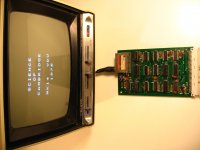One quick question - where did you get the keys from (in particular the key tops) for your MK14 keyboard?
Dave
I made the keypad you see in the clip when the MK14 was quite new, in other words, more than thirty years ago. Unfortunately, like many MK14 owners at the time I saw no reason to preserve the original keypad (it really was terrible) so I lost all but one of the component parts over the years. All I have now is the large square conductive rubber mat, arguably the most important part. At some point I may try to see if I can get a new upper frame and lower separator laser-cut - the key legend sheet I could probably reproduce myself. But for the time being, I don't think it looks too bad with the keypad it has.
Anyway, the key switches and key tops were sold by Maplin (electronics chain store in the UK similar to Radio Shack in the USA, for readers who are not in the UK), but they stopped stocking them a long time ago. Radio Spares (RS), also in the UK were stocking the same type of switch and switch cap right up until the late 2000's but they don't seem to do them any more either. (I have been looking because I wanted to have some spares). I believe they were made by C&K but unfortunately that's all I can remember now.
The key tops were plain when I bought them - I lettered / numbered them using 'Letraset' rub-down transfers - it took roughly 3-4 attempts for each key top before I got the letter / number down in one piece and in more or less the right place. if you look carefully you can see that one or two are not perfectly centred. I then fixed / sealed them with a layer of clear matt polyurethane varnish. I wouldn't have the patience to do it all now.
Nowadays, if you bought some cherry key switches and some plain keytops, you might be able to get the keytops engraved by a jeweller or a signwriter for a reasonable price. Or, if you went to a maker fair you might find someone who can work out a way to print the key legends directly onto plain key tops for you and make them permanent by printing a layer of clear sealant over the top.
Incidentally the keypad was built on ordinary stripboard / veroboard, but before I fitted the switches I placed a piece of black modeller's 'plasticard' over the top of the veroboard and cut it to exactly the same size - then I drilled through the black plastic card in the right places to let the pins of the switches pass through it and through the veroboard before being soldered on the copper side of the veroboard. The wiring from the keypad to the MK14 is all hidden under the keypad, lightly tack-soldered onto the tracks in the appropriate places.


